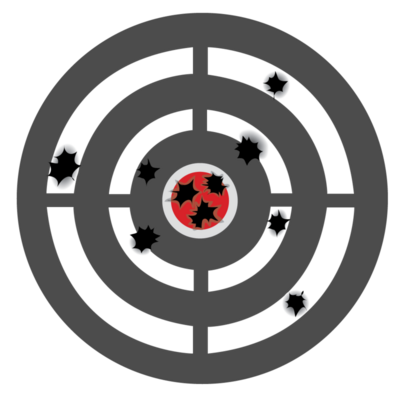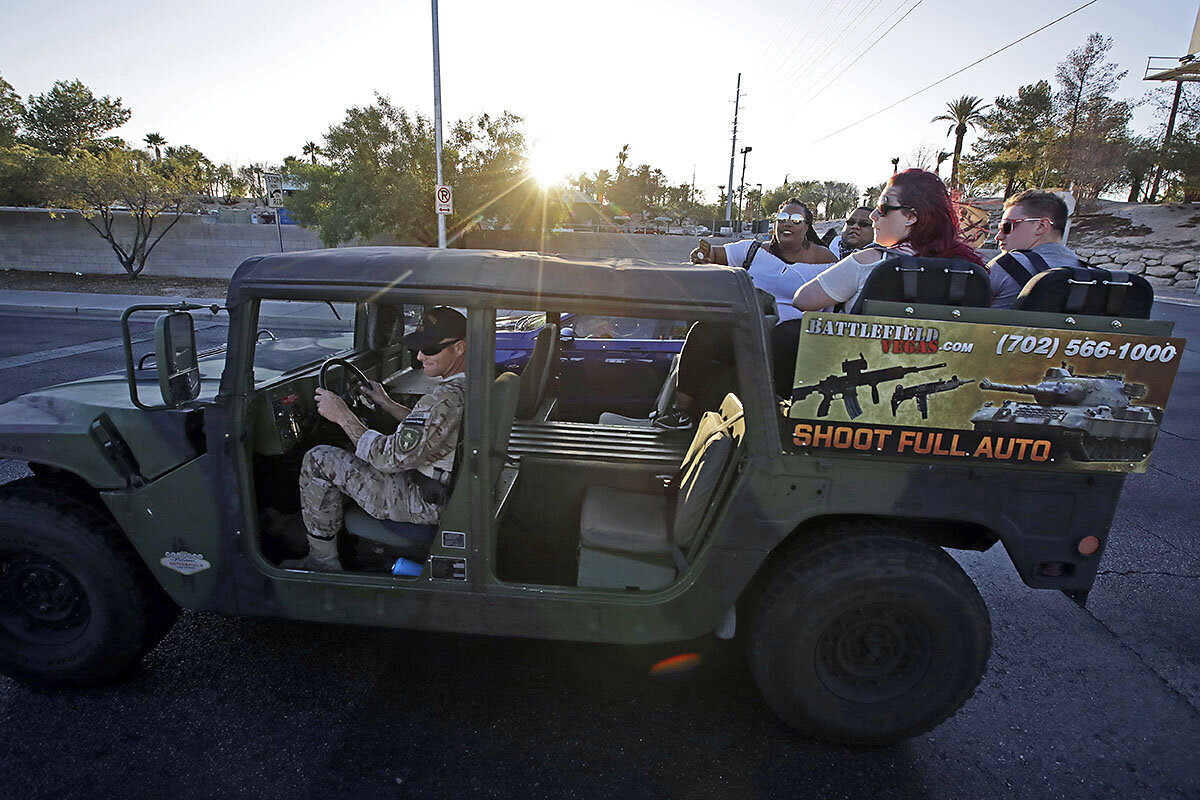My heart was pounding as I stood in front of one of Las Vegas’s many fantasy-themed gun ranges.
For reasons personal and professional, I wanted to shoot a gun for the first time – and join the 72 percent of US adults who already have. But it was a moment of sorrow and political tension. I was a reporter who had immediately flown west to Las Vegas to cover the latest of America’s mass shootings – and the wide cultural divide between regions of the country, at least when it comes to guns.
In New York City, where I live, there are only a few gun ranges, including a single range open to the public in Manhattan. No one in my closest circle of friends owns a gun, as far as I know, and though I am originally from a conservative community in south-suburban Chicago, I cannot recall even seeing anyone shoot a gun. So I was curious.
Nevada is one of the least restrictive states for gun owners. But in Las Vegas, the country's entertainment capital, a host of gun ranges market fantasy packages for tourists from all over the world. Many of them, one range employee told me, have also never shot a gun before.
“Looking for the ultimate adrenaline rush?” asks Battlefield Vegas, one of the top attractions in the city, according to TripAdvisor’s “fun and games” section. The entertainment venue picks up patrons from their hotels with a Humvee and offers experiences with weapons “from the trenches of World War I all the way to current operations in the Middle East.” One of its more popular packages allows customers to shoot real weapons featured in the video game “Call of Duty: Black Ops.”
Strip Gun Club, a popular gun range on the Vegas strip, also markets packages for women, including “Boom for the Bride” bachelorette parties. Another range, Machine Gun Vegas, offers bachelor parties that combine shooting guns with a limo ride to a gentleman’s club afterward.
I wasn’t the only reporter to visit these gun ranges, of course. Understandably, employees of nearly all of the ranges declined to comment on the mass shooting or their business models, citing respect for the victims and their families. Off the strip and miles from the bright din of casino lights and colors, range owners and patrons dismissed such entertainments – “tourist traps” for clueless newbies, such as myself.
Most were suspicious of journalists like me who were seeking them out during this moment of tragedy, unwilling to talk on the record since they worried my motives might include portraying gun rights advocates as callous. “We felt it, and we hurt,” wrote Meredith Dake-O’Connor in The Federalist, echoing the feelings of many gun rights advocates. “As hard as it may be to imagine, a person can watch this, ache, hurt, and be profoundly affected by these events and not change his or her position on the Second Amendment.”
Like some of the range employees and gun owners I talked to, Ms. Dake-O’Connor also complained that many journalists were just ignorant about the details of guns and gun ownership.
I was under no illusions that a single visit to a Vegas gun range would somehow give my reporting added credibility. And I was not immune to the fantasies and adrenaline rushes marketed to thrill-seeking tourists on the strip.
So for $160, I purchased a “Zombie” fantasy package online from a Vegas gun range I didn’t visit earlier, and I was feeling a bit nervous. (Managers at the ranges I had visited politely but firmly declined my requests to pay to shoot at their facilities.)
After I walked in, my trainer, who I will call Jim, had me choose four paper targets, one for each gun, as well as ear and eye protectors.
My first weapon, and the first gun I ever fired, was a Springfield XDM9, a 9mm semi-automatic pistol made in Croatia, and often marketed to beginners. Jim gave me basic instructions. I set my feet, and holding the pistol with both hands as instructed, shot at a 23” x 35” paper target – a picture of the racially ambiguous Terrorist No. 1, masked, wearing jeans, and carrying a machine gun.
A bullseye. After a few more careful and deliberate single shots, I then squeezed off a number of rounds as quickly as I could. In the end, I hit the target 12 out of 20 times.
Next was a fully automatic Glock 17 carbine — which, to a beginner like me, seemed basically a pistol placed into a device that made it a machine gun. I had chosen a classic target even I recognized: Ice-QT, who looks like a stocky, angry-looking '50s-era bank robber, a white man with his hair slicked back as he points a pistol directly at you. (Ice-QT is also the official qualification target for U.S. Immigration and Customs Enforcement officers.)
I shot a few short bursts into the paper silhouette’s chest. Of the fifty rounds I had, only two missed the target. I felt pleased.
My next weapon was classic pump-action 12-gauge shotgun. Jim loaded it with five 8-pellet buckshot shells. This silhouette, Big Helmut, was a bright green and yellow zombie. Feeling more confident, I embraced the fantasy. I aimed and pulled the trigger, shooting directly into the zombie’s chest — which I knew, as a fan of AMC’s “The Walking Dead,” doesn’t stop a zombie.
I pumped the shotgun’s fore-end, and shot again, feeling the gun’s famous recoil. For my last three shots, I decided to shoot as quickly as I could, like in the movies: Boom, chick-chick. Boom, chick-chick. Boom.
“That was awesome,” I said. “Yeah, makes you feel like a man,” Jim said as he flicked a switch and drew the target back to the booth. “You could put your fist through the hole you put into him.”
In my head, I briefly thought of the gendered discourse of power. This range also included small pink pistols marketed for women. It, too, offered special bachelorette packages. In truth, before I went in, I wondered if I should start with smaller weapons, and purchase such a package. In truth, this former high school and college wrestler could never do that, for reasons worth reflecting on.
But I was eager to shoot my final weapon: the AR-15, equipped with a scope. For what may be the most famous, or infamous, gun in the country, I chose the plain blue silhouette B-27E BR with a small red bullseye in the center. The target includes a score chart used to produce certification scores.
Jim moved the target as far back as it could go – about 10 meters. I concentrated, feeling competitive. The weapon, and the scope, was simple and elegant. My first five shots, cautious and deliberate, hit the inner X of the red bullseye. I quickly fired five more rounds. Each of my 20 shots, in fact, hit the red of the bullseye. (OK, one bullet was mostly outside the bullseye, but it grazed the red, so I’m telling everyone I got 20/20.)
I felt proud. But I also felt a deep respect for the design of this weapon, often called “‘America’s rifle.” If a newbie like me, shooting a gun for the first time in his life, can perform this well with minimal training, it obviously has more to do with the weapon’s efficient design and the utter ease with which a person can handle, aim, and shoot a target.
But it’s also an efficiency that troubled me. My editor messaged me, asking if I was a convert to gun ownership. “Good question,” I replied. “I was struck by the incredible and instantaneous power of these weapons – and I could see being interested in the sport of marksmanship,” I messaged back.
But I was not ready to own a gun, or carry one in public, I told her. “My heart is still pounding, and I’m thinking of what it means to wield such power, relatively speaking, over life and death.”






